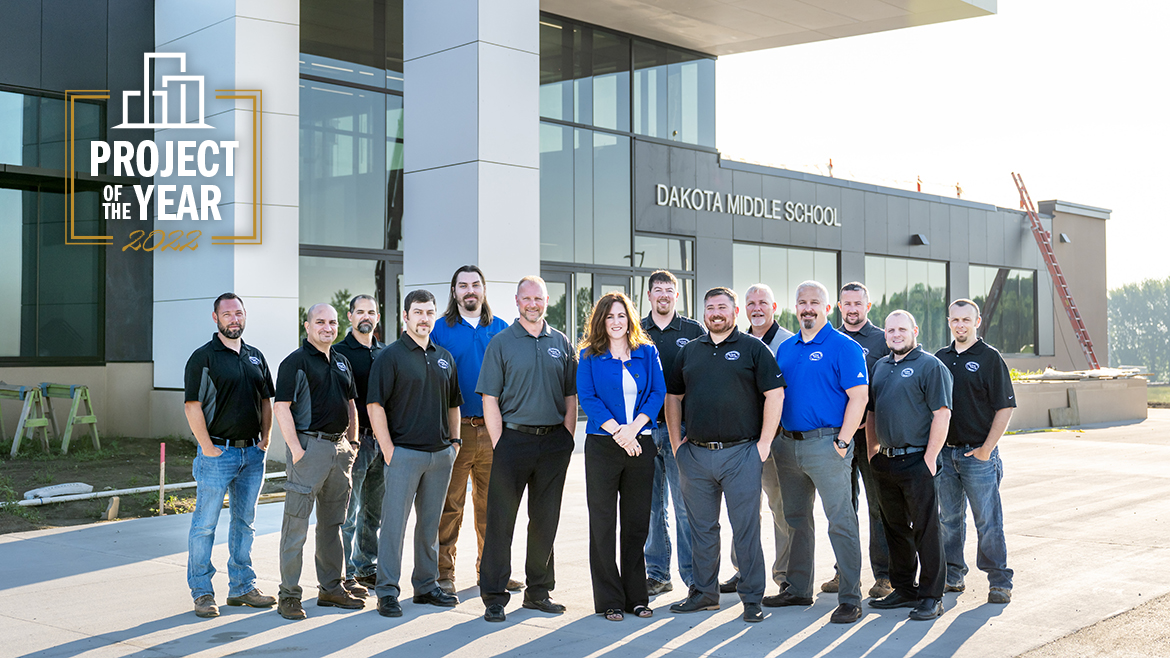Faced with soaring enrollment and a critical need for district-wide capital improvements, Rochester Public Schools in southeastern Minnesota asked voters in 2019 to support a large bond referendum. The district was burdened with many facility challenges that could not be addressed within its standard operating budget. Among the most pressing must haves: greatly heightened school safety for more than 18,000 students, plus faculty.
Residents saw the necessity and approved the referendum. The district has since been busy allotting $181 million for both new construction and overhauling existing buildings, with project completion expected before students return to classes in September. Central to the improvements is roughly $7 million for life safety and security enhancements, such as redesigning main entrances at schools to better monitor and control visitor access.
All visitors to district schools will be routed through a main office before gaining access to the rest of the grounds. Additionally, the schools’ door-locking systems are being updated so all access points can be remotely monitored. And state-of-the-art fire alarm solutions are replacing legacy systems to meet new code requirements, as well as provide emergency notification and lockdown alerts never before deployed at district facilities.
SDM 2022 Project of the Year at a Glance
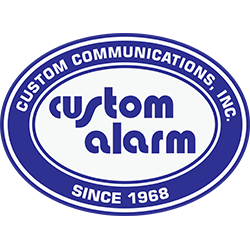

Winner: Custom Alarm, Rochester, Minn.
Employees: 70
Customer: Rochester Public Schools, Rochester, Minn.
Scope of project: Upgrade the fire alarm systems to include voice evacuation at 20 existing schools and facility buildings, and install brand-new fire alarm systems at three newly constructed schools.
Project launch: June 2021
Project completion: Estimated to be completed by September 2022
Rochester-based Custom Alarm (No. 75 on the 2022 SDM 100 Report) is largely responsible for the upgrades and new installations as part of the bond referendum’s fire alarm system and emergency alert earmarks, which total more than $2 million.
For Custom Alarm, the Rochester Public Schools bid project — a four-year-long endeavor all told — is the largest such undertaking in the company’s 54-year history. It has also garnered the locally owned and operated company SDM’s inaugural Project of the Year honor — in part for the extent of the work across more than 20 buildings, as well as surmounting difficult project hurdles and providing overall excellence in exceeding its customer’s life-safety requirements.
Project Scope & Size
Custom Alarm’s involvement with the project began in earnest in 2018 when Sales Engineer Joe Week began informing district officials how the latest technology could help them achieve their fire/life-safety goals and code requirements. The company’s close collaboration with the district and its advocacy for the referendum would prove essential to its passing.
“Even though this project was based off a bid, we worked from the very beginning to have this project included in the bid referendum,” Week explains. “If this was not completed the Rochester Public School District may not have been able to not only meet code changes, but also build off this to include different security and safety measures with the addition of the notification systems.”
Up until 2018, the Rochester School District used two different fire alarm systems, without either brand being upgraded in nearly two decades. Administrators concluded a facelift was in order and while doing so decided to standardize on one fire alarm system manufacturer.
With Custom Alarm’s guidance, the decision was made to proceed with the Notifier by Honeywell NFS2-640 addressable fire alarm control panel throughout the district — Minnesota’s seventh largest district with 27 schools and a half dozen support and community education buildings.
The scope of Custom Alarm’s winning bid was to upgrade the fire alarm systems to include voice evacuation at 20 existing schools and facility buildings, and then install a brand-new fire alarm system at three newly constructed schools. (The installation at a fourth new school was performed by an electrical company.)
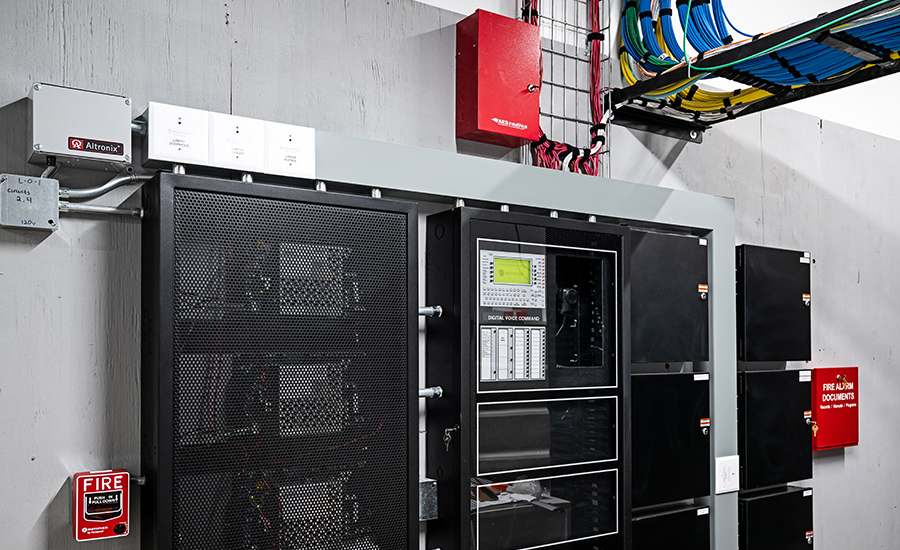
Custom Alarm standardized the fire alarm and emergency notification systems at 23 schools with the Notifier by Honeywell NFS2-640 addressable fire alarm control panel. The dealer also installed power supply gear by Altronix and wireless mesh network technology by AES Corp.
Custom Alarm partnered with multiple electricians to assist in completing the work, explains Sales Manager Brandon Clig. “Some of these partnerships involved ‘parts and smarts’ type jobs where we provided all the equipment and the final programming, but the electricians provided the labor to install,” he says.
Clig credits the intensive project for helping Custom Alarm to become a better company, both operationally and preparing it to go after similarly sized projects in the future. “We have learned a lot — from the technician standpoint, especially, how to now run multiple school projects at one given time. We did a lot of hiring for this project. We added three team members to our fire alarm installation team over the course of this project,” he says.
Custom Alarm CEO Melissa Brinkman further details how the project has changed how the company prepares for installations. “We redesigned how we handle the installation materials such as brackets and back boxes and preassembled them in-house and prepped everything before going to the job site, which cut down on time out in the field,” she says.
“We redesigned how we handle the installation materials such as brackets and back boxes and preassembled them in-house and prepped everything before going to the job site, which cut down on time out in the field.” — Melissa Brinkman, Custom Alarm
The company also altered its game plan for the installations, with a new strategy to install boxes, then pull wire, then mount devices.
“This helped us be more efficient overall with the installation,” Brinkman says. “Since this job we now do the prep and prework on jobs before techs are out on the job site. The prework and planning has helped us be more efficient as we continue to take on large installations.”
Voice Evac, Lockdown Ingenuity
Custom Alarm worked closely with Notifier Regional Sales Manager John Muhle to demonstrate for the district how the solution can prepare them for upcoming code changes. The district also learned it could add notifications for different critical alerts, all through the Notifier Digital Voice Command (DVC) on an Onyx Series fire alarm system.
“They were impressed with its capabilities and that all could be tied together and be future proof,” Clig says. “Additionally, in selecting just one manufacturer, we proved how it would be more cost effective and easier to use and monitor, as well as maintain with a consistent and uniformed system.”
With the Notifier technology, Custom Alarm was able to provide two different notification alerts in addition to the required fire alarm voice notification. The two alerts are used for lockdown situations, as well as inclement weather notifications. These were tied into the fire alarm system so that the alerts could be annunciated audibly through speakers installed throughout the buildings.
The installations include remote paging units as well: one located by the fire alarm panel and another deployed by main offices. Prerecorded messages can inform students and faculty about an alert, as well as direct them where to evacuate per school procedures.
“The school was able to get funding because of the emergency communications system, which is how it was all approved,” Brinkman says. “The fire alarm installation — with lockdown and weather alert all tied into one — allows the whole district to upgrade its system and overall functionality.”
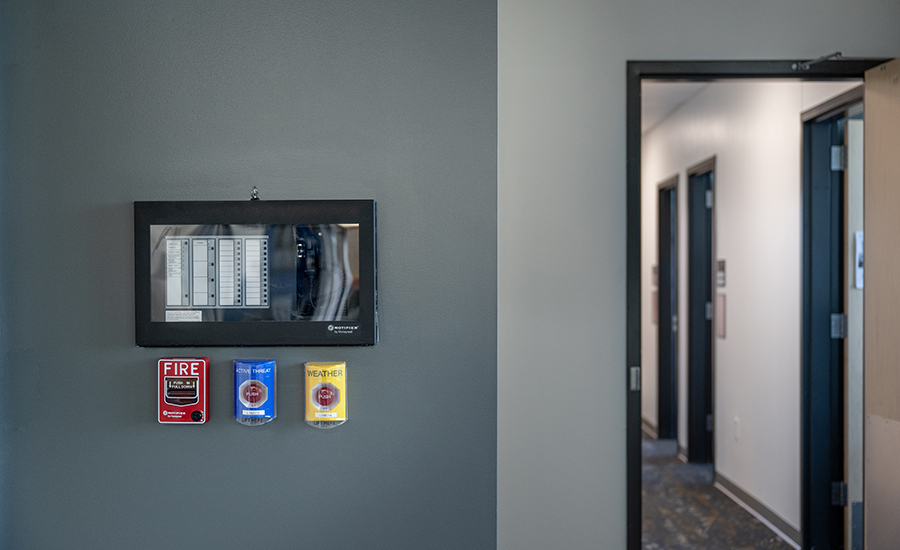
The fire alarm system installations include remote paging units, as well as the ability to broadcast pre-recorded alert messages.
In explaining the uniqueness of the newfound life safety capabilities, Clig says school districts oftentimes have a PA speaker system and another push-button system for emergency alerts. Not many schools, though, have a solution where these functionalities are integrated into one unit.
“Through this fire alarm system we have different push buttons the schools can push in the office, and we have them in place in a couple of different locations throughout the schools,” Clig explains. “When they push that button, it’s going to drop those door holders, so certain areas of the school are physically going to be locked down. And then we’re going to notify each one of those classrooms. We’re going to notify any kids that are in the hallways; when they see that color strobe, they know what to do, they can go into their procedures whether it be shelter in place or go to a secure area.”
The new solution brings school district facilities into compliance with the Americans With Disabilities Act (ADA) and NFPA 72. (Minnesota adopted the 2016 edition of NFPA 72 in 2020.)
Higher code compliance was a significant benefit of the upgrades, says Leah Barbosa, a project engineer for Rochester Public Schools.
“A big draw for us was the inclusivity that this system provides for staff and students who are hard of hearing or visually impaired, as well as for those who were sensitive to the loud horn sound that we previously had,” Barbosa says. “It has also helped us bring the drills we do for fire, weather and active threat into one district-wide standard, so no matter which building staff are in, they know what action to take and what to expect in any of these events.”
Still another main feature that brought the school district around to the advantage of the Notifier solution was the Connected Life Safety Services [CLSS], Muhle says. “This utilizes the power of the cloud to not only monitor the systems through traditional central stations, but ensure code compliance with respect to inspections and inspection reporting.”
CLSS uploads the panel inventory, ensuring that all devices are listed in the inspection, and therefore are inspected. Failsafe measures enable the technician to list only the untested devices making it quick and efficient to double-check complete system inspection. The cloud connection enables the capability to perform inspections and interact with the panel from an app on the technician’s phone.
“CLSS also allows the technician to make point description changes from the app, eliminating the need for a return trip to reprogram directly into the panel,” Muhle says. “Because this information is shown on the technician’s phone, the need for a second technician at the panel is unnecessary.”
Overcoming Installation Obstacles
Given the extent of the project and its geographic expanse — the district spans more than 220 square miles — Custom Alarm knew going in they would not be able to fully operate and complete the work entirely in-house. Collaboration and subcontracting with other low-voltage specialists would be essential at many of the project sites led by Custom Alarm. The company’s long history in the community and reputation as a respected partner paid dividends in other ways as well.
Custom Alarm ended up being a blessing of sorts for a local electrician who also had been awarded five of the referendum’s school upgrades. The scope and abbreviated time frame to complete the work proved a shade unnerving for the electrician. But his familiarity with Custom Alarm — and their own need to partner — created a winning relationship. For these five jobs, the electrician came in as the prime bidder and Custom Alarm worked underneath him.
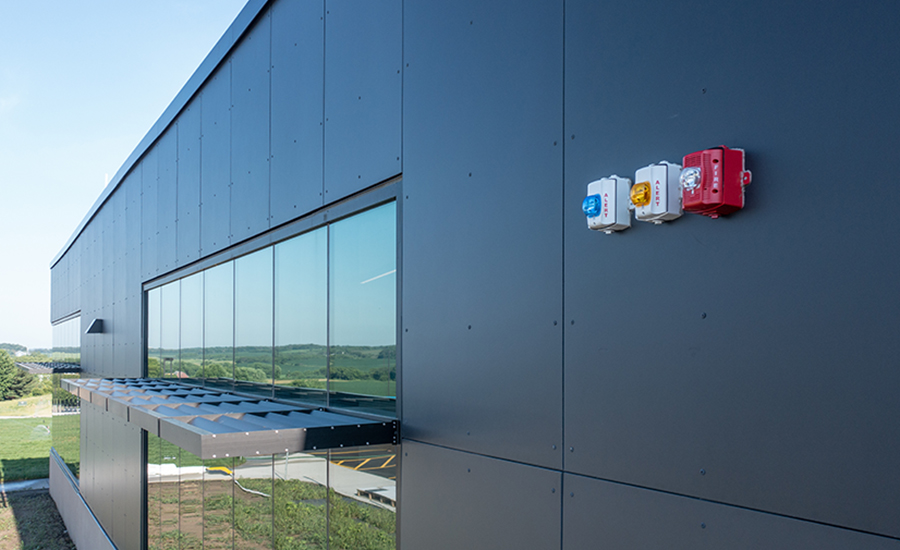 Two distinct alerts are used for lockdown situations, as well as weather notifications. These are tied into the fire alarm system so that the alerts can be annunciated audibly through speakers installed throughout the buildings.
Two distinct alerts are used for lockdown situations, as well as weather notifications. These are tied into the fire alarm system so that the alerts can be annunciated audibly through speakers installed throughout the buildings.
“The electrician was able to do all the physical installation last year,” Clig explains. “He did all the cabling, he did the devicing. And then our guys would come in and do the programming. We would go in there and set all the devices, do the backend programming to make sure those devices worked, making sure the notification devices were going off.”
Of course, no installation is without surprises. Once work commenced last summer, Custom Alarm soon discovered the facility drawings from an architect and engineering firm were “only as good as what they could physically see,” Clig says. The partially inaccurate drawings, which are supposed to chart where various legacy system devices are located, have continued at times to hinder the pace of work at existing schools.
“It’s challenging when you’re up there above ceiling tiles or in the rafters and there’s a duct detector or fire smoke damper that wasn’t on the drawing,” Clig describes. “But you’re seeing it in person, so just staying on top of those change orders, making sure that we’re getting to each one of those devices and making sure that it’s part of the system, it’s been a challenge.”
Work at the three newly constructed schools has presented a separate set of issues, mostly around timing. As with any new build out, just staying on top of a fluid construction schedule is half the battle. Custom Alarm techs may not have access to a site for up to three weeks.
“And just when we think we’re off for that extended period we get the call, ‘Hey, I need you guys here tomorrow to get this done,’” Clig describes. “So you are readjusting the schedule. It’s a lot of good work from our operations team and from our scheduling department to meet the district’s needs. Our project manager, Eric Manahan, was really involved with that and making it all happen smoothly and efficiently, keeping the customer happy.”
Supply Chain Woes Aplenty
The biggest hurdle by far Custom Alarm has faced during the abbreviated installation schedule was getting product. The supply chain crisis reared its ugly head from the get-go, necessitating the company implement tactics it never before employed. It leaned heavily on Notifier to help it purchase a huge bulk order — enough to complete the entire project, which unfolded over the past two summers.
“Initially we were concerned about supply chain issues dating back to March 2021; we ordered everything for the project and rented a separate storage unit to put product in as it arrived and housed it here,” Brinkman explains. “We still have issues with product not arriving in a timely manner, but were able to get started and complete the majority of the project on time.”
The experience has caused Custom Alarm to shift its practice to now ordering product as soon as the job is sold and processed, opposed to waiting to order after the job is scheduled, which was their previous standard practice.
“This still causes issues for us due to the extremely long lead times on some product, but we are in a better position to meet our customers’ needs and timelines,” Brinkman adds. “We have taken on more inventory and costs, but in the end we made the business decision that it was worth the additional upfront investment to minimize the impact to our business and to our customers.”
Clig credits Muhle and his efforts in helping the company secure its equipment needs. “He’s done a really good job of pulling strings and making sure that we’re getting the product, and then just working with us on any of these change orders, putting in a rush on it.”
Muhle adds, “This year has been a real challenge for our industry with material constraints and record inflation, not to mention the effect of higher shipping charges. Because Custom Alarm involved me very early in this project, I was able to get high-level commitment from Honeywell leadership to ensure this project would be prioritized commensurate with the size and scope of this project.”
“This year has been a real challenge for our industry with material constraints and record inflation, not to mention the effect of higher shipping charges.” — John Muhle, Notifier by Honeywell
Custom Alarm has contended with several price increases over the course of the project, which continued to affect change orders. Yet the company elected not to pass along the price hikes to the school district. Rather than nickel-and-dime the customer they felt it was better from a relationship standpoint to absorb increases and continue to build their relationship with the district, Clig explains.
“We knew there were going to be other opportunities for us to continue to build off of that relationship with the fire alarm system monitoring, with some of the new wireless communication methods that we were going to put into place with this project,” he says.
Fire Alarm Equipment List
Following is a list of fire alarm equipment that Custom Alarm typically installed at each of the project sites.
- Notifier Onyx Series 640 fire alarm control panel (1)
- Notifier digital voice command with keypad DVC-KD (1)
- Notifier RPU remote paging unit with microphone (1)
- Notifier network control annunciators (1)
- Notifier remote annunciators LCD2-80 (1-7, dependent on size of school)
- Notifier addressable FSP-951 smoke detectors (quantity depends on school size)
- System Sensor DNR duct detectors with FSP-951R smoke detector heads and an RTS-151 test switch (quantity depends on number of HVAC units)
- Notifier addressable NBG-12LX pull stations (quantity depends on school size)
- Notifier addressable FMM-1 and FMM-101 monitor modules and mini-monitor modules (used for monitoring sprinkler system)
- Notifier FCM-1 control modules (used to tell the NAC power supplies to fire off when button has been pushed)
- System Sensor speaker strobes (quantity depends on school size)
- Notifier DAA2-7525 digital amplifier (quantity depends on number of speaker devices)
- System Sensor strobes (used for visual notification)
- System Sensor LENS-BC2 blue lens covers (used for visual notification of lockdown situations)
- System Sensor LENS-AC2 amber lens covers (used for visual> notification of weather alerts)
- STI pushbuttons (used for pushing to manually trigger weather or lockdown situations)
- Altronix power supplies (T2428175C 24VAC 7.25AMP with enclosure) for door holds
- AES 7707P-88-M Intellinet 2.0 Fire Subscriber mesh network for primary form of communication
This includes installing mesh network technology by AES Corp., which, as the primary communications path, will help fortify school district alarm systems against the looming POTS sunset. Notifier’s CLSS platform is also expected to eventually generate recurring revenue for Custom Alarm, while helping district maintenance personnel spot and fix technical issues early, before they result in unforeseen operational costs.
Custom Alarm views the technology advances and new service offerings as an opportunity to deepen their relationship and continue the role as trusted advisor — a notion that is ever more vital given the heightened awareness and concern for protecting the lives of students and faculty on school campuses.
“We knew there were going to be other opportunities for us to continue to build off of that relationship with the fire alarm system monitoring, with some of the new wireless communication methods that we were going to put into place with this project.” — Brandon Clig
In Brinkman’s view, security providers especially have the responsibility to stay on top of technology and work with the manufacturers to provide solutions for end customers and all of their unique needs.
“We pride ourselves on being the local, trusted security partner to our customers,” she continues, “and now more than ever they are looking to us to help them find ways to leverage technology in an effort to keep the students and schools safer and to have early notification should something occur on school property.”
